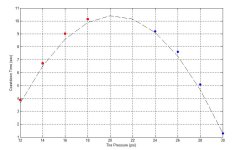npalen
Elite Member
How about jacking up ONE side of the tractor just enough that the front and rear tires are just free to rotate with 4WD or FWA engaged. Will probably require a jack at front and rear.
Then, with a helper, run a rope, twine, tie strap or similar between the front and rear tires and wrapped around the outside of the tires. Mark the rope just behind the front tire also mark the floor at this point. Rotate the REAR tire while keeping the rope held in original position on the circumference of both tires.
Stop when the mark on the rope gets near the rear tire then measure the distance traveled. Then measure the slack in the rope and divide this by the the distance traveled to give and indication of percentage of front wheel lead.
The idea here is that the gear ratio should cause the front tire to "travel" faster than the rear causing the rope to go slack.
Disclaimer: I've not done this so it's subject to broad criticism, constructive or otherwise.
Then, with a helper, run a rope, twine, tie strap or similar between the front and rear tires and wrapped around the outside of the tires. Mark the rope just behind the front tire also mark the floor at this point. Rotate the REAR tire while keeping the rope held in original position on the circumference of both tires.
Stop when the mark on the rope gets near the rear tire then measure the distance traveled. Then measure the slack in the rope and divide this by the the distance traveled to give and indication of percentage of front wheel lead.
The idea here is that the gear ratio should cause the front tire to "travel" faster than the rear causing the rope to go slack.
Disclaimer: I've not done this so it's subject to broad criticism, constructive or otherwise.
